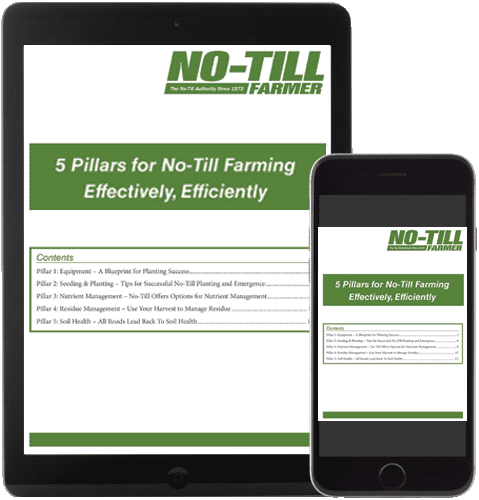
Get essential tips and techniques that successful no-till farmers use to boost crop yields and increase profits!
No-Till Farmer has put together the ultimate guide including the best ideas and advice to help you succeed in no-till farming’s five core management topics: Equipment; Seeding and Planting; Nutrient Management; Residue Management; and Soil Health.
This FREE downloadable eGuide, “5 Pillars for No-Till Farming Effectively, Efficiently,” immediately offers you a collection of practical advice for:
- Modifying or building your own planter for top performance
- Setting up crops for high-yielding potential when seeding and planting
- Picking a system that safely feed nutrients through the growing season
- Managing your crop residue during harvest
- Promoting healthy no-till soils through judicious use of cover crops and careful use of fertilizer and agricultural chemicals
This 19-page eGuide is jam-packed with diverse tips on every facet of no-till farming. Best of all, it’s FREE!
Discover an Equipment Blueprint for Planting Success
As NO-TILLERS, we’re challenged with configuring planters that can handle residue and properly place seed in the soil.
Get expert advice for setting up a planter including how to handle residue, how to open and close the furrow while firming soil around the seed, and how to precisely place the seed at the right depth and spacing. You’ll learn all of this while also ways to minimize any risk of compaction or crusting.
When you download this eGuide, you’ll immediately get practical no-till advice and tips that you can put to use immediately, such as:
- Maintain sharp double disc openers
- Maintain proper disc spacing
- Level the planter
- Keep residue uniform
- Don’t seed between the old rows
- Watch planting speed
- Maintain proper down pressure
- Prevent sidewall compaction
- Place seeds at proper depth and at the bottom of the seed furrow
- Close the furrow
Get the Best Tips for Successful No-Till Planting and Emergence
As a no-tiller you know you only have one shot to set your crops up for high-yielding potential, so focus on what’s required to achieve a quick, even emergence and vigorous stand this spring.
In this 19-page eGuide you’ll learn how to plant with precision at optimum populations across your fields. You’ll learn how to achieve a more uniform planting depth, which results in more uniform emergence. Plus, why it’s key to identify the most important aspects of your field before you invest in mapping, including topography for water flow, soil pH, organic-matter content and yield data.
Learn the Many Options No-Till Offers for Nutrient Management
You’ll learn how to pick a system that safely feeds nutrients throughout the growing season which can help your crop reach its yield potential. Here’s a look at the many options you’ll learn more about in this FREE eGuide:
- Nitrogen At-Plant
- More 2-By-2, Pre-Plant
- More Starter, Sidedress
- Large Planters, Narrow Rows
- Dribbling Nitrogen
There are surely other ways to apply nitrogen that also will work well, but the most important thing you’ll take from reading more in-depth about these tips is to make sure your system is supplying adequate amounts of nitrogen throughout the growing season.
Get Expert Advice and Best Practices for Managing Residue Levels
Many factors affect the amount of residue you’ll find in your fields, and how long it will hang around.
These factors include crop type; GMO biotech traits; carryover of residue from the previous year; the type of residue processing on your combine; the type and timing of field operations; and soil moisture and exposure to sunlight.
You’ll get learn the best tips for managing corn residue such as using a corn head that chops up the corn-leaf residue and upper stalk parts, but leaves the rest of the stalk standing upright. If you’re handling small grains or soybeans, it’s important to properly adjust choppers and/or spreaders to uniformly spread residue across the whole field
Plus, Learn Soil Health Tips from NRCS Soil Scientist Ray Archuleta!
NRCS soil scientist Ray Archuleta believes promoting healthy no-till soils requires a lot more than just ceasing tillage operations. It means following the lead of nature.
Download this FREE 19-page eGuide to learn:
- Why Archuleta advises farmers to randomly select aggregates, or clods, from a field or fields and let them air dry, or microwave them until all the moisture is gone. When the aggregates are dry, drop them into a jar of water for each sample
- What the primary reason for organic glue degradation is
- Why Cover-crop residue helps regulate temperature and moisture in the soil
- And much, much more


